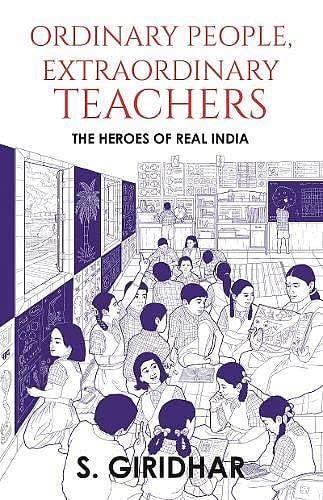To Teachers, With Love

S. Giridhar’s book is a tribute to those countless teachers, working in far flung government schools across India, who are quietly making a difference to improve learning levels and build knowledge amongst lakhs of Indian school children from the most disadvantaged sections of society and for whom the only chance to break the cycle of poverty and illiteracy, is to be educated. The book brings out sharply the odds that head teachers and teachers overcome, to make schools function and help first-generation learners get on with their education. The simple and effective strategies that enable this appear to be replicable. This book, must therefore, be a compulsory read for all teacher education programmes.
The author has based his views on a qualitative study of selected 110 ‘good’ schools in the states of Karnataka, Rajasthan and Uttrakhand and has teased out the ‘processes and practices’ that contribute to a change in school culture, the quality of the pedagogy, the nature of school leadership and managerial support needed, to ‘transform schools’ into learning places.
The author has a touching faith that government school teachers are highly committed to their task despite severe personal and professional challenges of teaching in schools located in lonely, distant and inhospitable areas. In Uttrakhand the terrain and climate is a ‘logistical trial for students and teachers alike’. Adverse ‘teacher-pupil ratios are inimical’ to sustained learning practices, as is irregular attendance of students from migratory families in some districts of Karnataka and the teaching of tribal students in Rajasthan whose home language is different from the schools’ medium of instruction Hindi, are challenges.
Some key ingredients are highlighted as critical to the transformation of government schools. School leadership matters, a good Head Teacher ‘is akin to a CEO of an institution’ who can turn around the organisation with good communication with the parents and the community to ensure regular student attendance, mobilise local resources; build rapport with the School Management Committee to plan and budget for school improvements; provide academic leadership for application of new pedagogic practices in multi-grade classrooms and conduct regular reviews of teacher and student performance. Equally significant are the Head Teachers’ own abilities for clear headedness, strategising, team building, incorruptibility, courage and determination, as well as ability to garner support from supervisors for funds or posting of additional teachers etc. Once the trust and bond with the local community is established and teaching learning processes show improved learning outcomes, the school is set on its course as a respected and valued public institution.
The book underlines the idea of a ‘reflective teacher’ which is often the goal of countless Government teacher training programmes. The 300 ‘good’ teachers covered in this study seem to have benefitted and managed to carry new ideas into the school and classroom to effect improvement. It made them more confident to ‘exercise more autonomy in the classroom’, innovate with timetables, teaching methods, classroom organisation and assessment systems. It also positively impacted ‘equity in the classroom’ where every child’s learning level mattered and the dynamics of the classroom changed to one where children were at ease with the teacher and the school. The teacher is the fulcrum who makes it possible for the student to learn, develop in confidence, imbibe the right values and develop a congenial persona.
The author however, does not quite confront the issue of why all teachers in government schools do not deliver along expected lines. More training, better teacher preparation and ongoing academic support is necessary, so are building teams, having smart goal setting and role models to emulate. Many of these things do happen, sometimes comprehensively, sometimes with individual drive but that has not proved to be enough for the systemic improvement of public schools. Standards of performance, which may well be self-generated, need to sustain overtime and must more fully permeate the public education system. Norms and patterns of accountability, systemic and individual, to attain desired standards of performance of schools and classrooms is the biggest challenge for the State Governments, even though ‘good’ teachers show the way.

